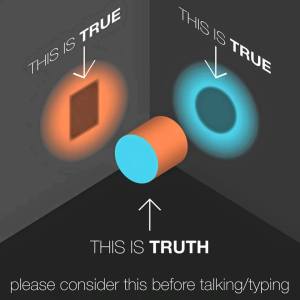This is the classical dualistic ontology in basic philosophy whose last vigorous defender was the Cambridge absolute idealist philosopher, F. H. Bradley whose magnum opus, Appearance and Reality was heavily criticized by both Bertrand Russell and G.E. Moore who incidentally were Bradley’s students. The meme is not quite philosophically accurate because that which is pointed as “This is Truth” is actually “The Fact” to which no truth-value is imputed because the fact is the basis of the truth. What makes a statement true is the fact but never do we say that the fact is the truth or vice versa.
1.0 Assumptions
1.1 Let A be construed as a concrete object in physical reality called “fact”.
1.11 Facts are not mental constructs but real objects in the world that constitute states of affairs.
1.2 Let x be the image of a square which is a perspectival reflection of a particular side of A.
1.3 Let y be the image of a circle which is a perspectival reflection of another particular side of A.
2.0 Truth-valuation
2.1 Truth-valuation, i.e., truth or falsity, is applied only to statements or propositions that (1) correspond or not to facts; or (2) cohere or not with other statements logically.
2.2 Truth-valuation cannot apply to A since A is the reference point that determines the truth or falsity of statements that correspond or not to it.
2.21 Truth-valuation cannot apply to x and y since x and y are not statements or propositions but images of A’s perspectival reflections.
2.3 However, we can formulate statements about x and y in relation to A as follows:
2.31 “x which is an image of a square is a reflection of A which is a square found in the world.”
2.311 This statement is false since A is not a square found in the world.
2.32 “y which is an image of a circle is a reflection of A which is a circle found in the world.”
2.321 This statement is false since A is not a circle found in the world.
(c) Ruel F. Pepa

